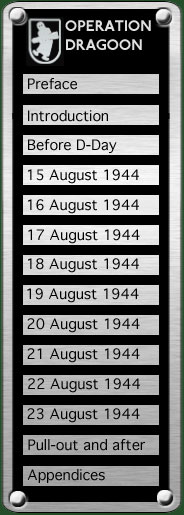
|
||
continued … Despite the problems at Valence, bomber operations resumed at dusk: the callsign for KG 26 was FAHNE ("flag"), for III./KG 100 it was GEMÄLDE ("painting") and for Blagnac flying control, LOTHAR. At 20.40, six Ju 88s dropped bombs between St. Raphael and St. Maxime without causing any damage while five minutes later the control vessel HMS Ulster Queen logged bombers and AA fire over the St. Tropez area, its Type 651 Receiver recording the release of "one radar-controlled bomb." First reports spoke of a glider bomb hitting the Charles F. Hughes but as it turned out the missile only registered a near miss and the ship was undamaged: Bogies were reported at 320º, 7 miles … two Ju 88’s [sic] were sighted and as fire was opened at about 9000 yards two more planes appeared below the original pair. Each of these had a red flare and dove directly on the ship … one of the gliders burst into flame, but came into land on the water 100–150 feet abreast Gun No. 3. It was a dud. Many pieces of the glider came aboard in the column of water, and one large piece of aluminum sheet caused superficial injuries to [two seamen]. The second glider bomb landed about 200 yards astern and exploded. The shock tripped out the main ACB breakers on the forward distribution board. Personnel in steering aft were thrown to one side, and gratings in the after engine room were thrown upon the gear casing. Minor damage consisted of glass breakage and derangement to motor controller of LP air compressor. At this time when power was immediately restored, the main battery computer was out in elevation and the Radar, Mk. IV was inoperative. Five of III./KG 100's Do 217s had operated: two aborted the mission; another jettisoned its Hs 293; two claimed near misses. Use of the Fritz X was reported to have been impossible on account of cloud cover, yet the crew of 6N+DR claimed a near miss on a 6–8,000 tonne troop transport with this weapon. Just under an hour later another American destroyer, USS Champlin, came under attack, this time from a low-flying Ju 88: Sunset was at 20.34 [local]. At 21.00 this vessel commenced firing on air target … no damage to the plane was observed. At about 21.35, Combat reported a “bogie” on Sugar George radar … Control picked up the target up at 9000 yards dead ahead and commenced tracking in full radar control. At 21.37 the CHAMPLIN commenced firing … Range at this time was 4900 yards … Visibility was about 1500 yards. By the time six [5-inch] rounds were fired, the plane was seen to burst into flames and after travelling about two hundred yarss, plunged into the water … It continued to burn for ten minutes. … The FD radar was working exceptionally well. Control was on target immediately with clear “pips” on both train and range scopes. The solution from plot was rapid and apparently highly accurate. Struck by the ship's return fire, the bomber exploded and I./KG 26 posted four NCO's missing. The Charles F. Hughes reported that: The bodies of the crew of one German aircraft were picked up later, but there was no indication that the one fired upon by this vessel was damaged. For its part, the German naval radar station at La Garoupe, Cap D’Antibes reported: 21.10 Enemy naval formations being attacked by German a/c. Heavy AA. Two huge smoke clouds visible in the formation, probably fires on two ships. 21.45 Bearing 180º, about [28–37 km] away, a heavy explosion persistent fire at sea. One naval unit hit and probably destroyed. At 22.15 hours, two II./KG 26 Ju 88s had managed to get off from Valence for radar coverage of the sea area between Nice and Corsica and south of Toulon. Three other aircraft were unable to take off owing to damaged propellers and the reserve turned out to have a fault with its undercarriage. From IC early on 18/8: Activity report No. 14. 17/8. III/KG 100. Operational strength 5 Do 217. 2 broke off. None lost. Successes. 2 near misses with Hs 5 metres short of bow and stern … (word illegible) … Transport of 6000 tons, heavily damaged. FX attack not possibly [sic] owing to thick cloud. Amn expenditure. 3 Hs (1 jettisoned). Special events. 15 minutes after take-off low-level attack by Lightnings on GAF station Toulouse-Blagnac. 1 Lightning shot down by a Do 217 curving in.
Movements With the Germans clearly not holding their own, assets began to be moved to safer locations and Luftflotte 2 in Italy requested Fl.Div. 2 to return one of its Me 410s immediately. At 21.00, JGr. 200 was ordered to transfer to the Dijon area while Aix-Les Milles airfield was to be destroyed. An advance party from 1./JGr. 200 had already moved to Avignon and was followed during the night by the rest of the ground echelon. En route, a 7-tonne lorry carrying aircraft mechanic Uffz. Karl Mokry and five others was hit by partisan grenade. The injured Mokry was taken back to the Marine Hospital at Aix-Les Milles and captured by the Allies on 21 August. Also that night, KG 26 directed its III. Gruppe to transfer with all its vehicles and equipment to the Reich frontier. No onward rail transport could be guaranteed however and everything was therefore to remain at the border. continued on next page...
|
|||

